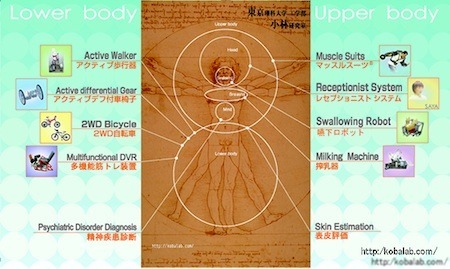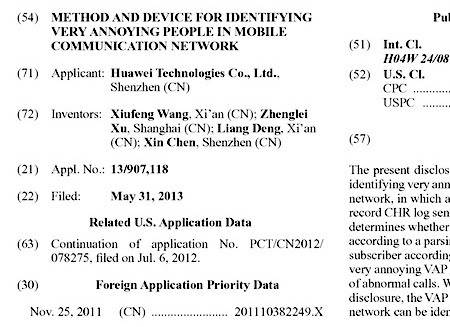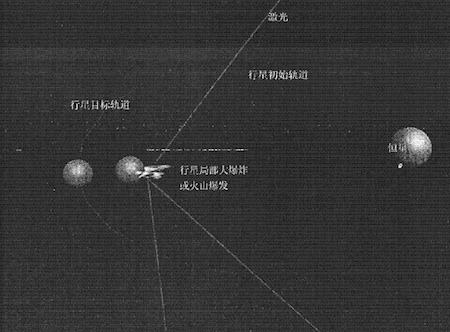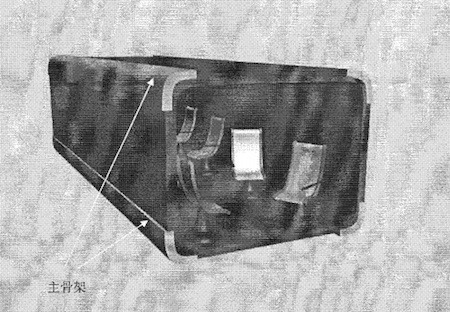Marc Abrahams's Blog, page 442
December 5, 2013
Sensing and Sensibility: “Development of Anal Position Detecting System for New-Toilet System”
Technology for the elderly grows more ambitious and, arguably, more adventurous. This paper sets a new standard:
“Development of Anal Position Detecting System for New-Toilet System,” Koshi Tokoro, Keisuke Fujihira, and Hiroshi Kobayashi [Department of Mechanical Engineering, Tokyo University of Science, Tokyo, Japan], paper presented at the 2013 Seventh International Conference on Sensing Technology, December 3 – 5, 2013, at Massey University in Wellington, New Zealand. (Thanks to investigator Ross Mason for bringing this to our attention.) The authors summarize what they did, and why they did it:
“Japan entered a super-aged society, and nursing care is a serious social problem. Especially, an excretion care causes physical and mental stress to both caregivers and recipients. In this study, we have been developing a new-toilet system for reducing the stress of the excretion care. The new-toilet system can capture feces and prevent odor dispersion by adhering tightly to buttocks. For attaching the device to buttocks, it is necessary to know the position of the anus. It is preferable that the device automatically moves to the anal position and adhere to the buttocks without caregiver’s help. Therefore we developed a sensing system of the anal position using the infrared camera. This paper describes the position detecting system and its estimation.”
Here’s detail from the paper:

Here’s more detail:
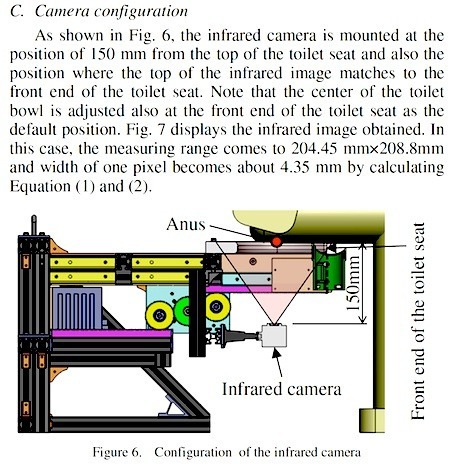
Their laboratory — the Koba Lab — is a hothouse of ideas and development. Among their projects: muscle suits, an artificial receptionist system, a swallowing robot, a milking machine, automated psychiatric diagnosis. And more. This graphic showcases many of them (click on the image to be whisked to a page where you can be further whisked to details of some of the projects).
They also once made a robot substitute elementary school teacher. This news video, from 2009, gives a glimpse of it:

Unscrew You, Spontaneously [a medical report]
When one has a screw loose, there can be medical implications. This study documents one such:
“Spontaneous expulsion of a screw: An unusual complication 3 years after internal fixation of posterior acetabular wall fracture,” Francisco Chana-Rodríguez, José Matías Tabernero Fernández, Manuel Villanueva-Martínez, José Rojo-Manaute, Javier Vaquero-Martín, Injury Extra, vol. 43, no. 9, September 2012, Pages 63–64. The authors, at General University Hospital Gregorio Marañón [the hospital is pictured here], Madrid, Spain, report:
“we present a novel case in which an acetabular screw spontaneously migrated 3 years after the surgery, undergoing subsequent transcutaneous expulsion”
BONUS: ”Screw Fixation of Acetabular Components“

December 4, 2013
Inventions to detect and prevent annoying phone calls, documents, or people
Annoying phone calls and documents clog our telephone, email, and other communications networks. Inventors, and the institutions backing them, are trying to fight technology with technology. Here are three of their patent applications:
“ Detecting and rejecting annoying documents ,” international patent application WO 2007070622 A3, Filed Dec 14, 2006 by Anurag Agarwal and Deepak Jindal (Google is involved): “A system and method for evaluating documents for approval or rejection and/or rating. The method comprises comparing the document to one or more criteria determining whether the document contains an element that is substantially identical to one or more of a visual element, an audio element or a textual element that is determined to be displeasing.”
“ Annoying Telephone-Call Prediction and Prevention ,” US patent application 20100278325 A1, filed May 4, 2009 by Navjot Singh, Saurabh Bagchi, Yu-Sung Wu (Avaya Inc. and Purdue Research Foundation are involved): ”A method for predicting whether a telephone call that is being set up will be considered annoying by the called party and, if so, for preventing it from being established. The illustrative embodiment predicts whether a telephone call will be considered annoying by the called party based on temporal characteristics of previous calls from the same caller. For example, when a called party receives an unwanted telephone solicitation, he or she will usually hang up within the first minute. If many telephone calls are made from the same caller, and all of these calls last under a minute, then it is reasonable to predict that future calls from this caller will be considered annoying.”
“ Method and device for identifying very annoying people in mobile communication network ,” US patent application US 20130260743 A1, filed May 31, 2013 by Xiufeng Wang, Zhenglei Xu, Liang Deng, Xin Chen (Huawei Technologies Co., Ltd. is involved): “The subjective perception of the subscriber is important for a telecom operator. If the subscriber has a good feeling for a certain communication service, the subscriber is promoted to use the service. In a statistical period, if the subjective perception of a subscriber is poor, and the subscriber cannot receive care from the operator, the subscriber may complain and even change carriers. Therefore, it is very necessary for a telecom operator to accurately identify potential subscribers who have poor subjective perception and may complain or change carriers, and offer preventive care to the subscribers, or offer active care to subscribers with important values.”

A logistical support bra for regulating eating behavior
 BBC News reports “Microsoft working on a smart bra to measure mood.” The researchers, some of whom are at Microsoft Research, others at the University of Rochester, NY, USA and at the University of Southampton, UK, themselves report details in a paper:
BBC News reports “Microsoft working on a smart bra to measure mood.” The researchers, some of whom are at Microsoft Research, others at the University of Rochester, NY, USA and at the University of Southampton, UK, themselves report details in a paper:
“Food and Mood: Just-in-Time Support for Emotional Eating,” Erin A. Carroll [pictured here], Mary Czerwinski, Asta Roseway, Ashish Kapoor, Paul Johns, and Kael Rowan. They say:
This research is focused on building a persuasive system for behavior modification around emotional eating. In this paper, we make strides towards building a just-in-time support system for emotional eating… we also designed a novel, wearable sensor system for detecting emotions using a machine learning approach. This system consisted of physiological sensors which were placed into women’s brassieres.
Here’s detail from that paper:
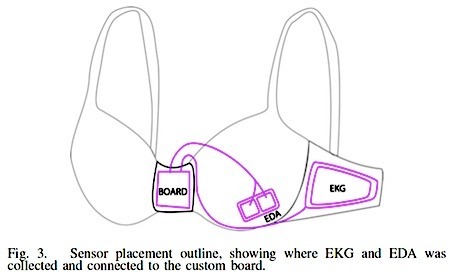
(Thanks to investigator Neil Judell for bringing this to our attention.)
BONUS (by other investigators, tending in a different direction): ”Fill Your Cup: Satisfy your appetite with fuller experiences and fewer calories”
BONUS (unrelated) The Ig Nobel Prize-winning emergency bra
BONUS (unrelated): A magnetic bra, as reported in the Daily Mail (thanks to investigator Lauren Maurer for bringing this to our attention.)

Planet kidnapping system, and a train
Few patents have been granted for systems to kidnap planets. This is a fairly recent application for one:
“Planet kidnapping system,” Chinese patent application 101948013 A, filed December 23, 2009 by 文华东. The inventor explains:
“The invention relates to a planet kidnapping system which uses laser to push asteroids to hit a target planet of moderate size based on preset tracks and contacts, so that the target planet can change the track thereof and move to a position required by people. The planet kidnapping system comprises a high intelligent information system, a cosmic ray station three-dimensional network system and an asteroid capturing system.”
Here’s a detailed diagram from the document:
The same inventor also filed an application for an unrelated space patent:
“Heaven and Earth Train,” Chinese patent application 102009751 A, filed December 2, 2009. The inventor explains:
“The present invention train line one kind of world. Dreams of the invention can train tunnel in heaven (see my world tunnel-related inventions) was run at a very low cost, so a lot of ordinary people and other things comfortably between the ground and too much space, and it is from the ground into space one of the best fast, safe, low-cost world of transport. The invention consists of intelligent computer system intelligent control hybrid engine system, the trunk.”
Here’s detail from that document:
The same inventor filed patent applications for many other space devices. However, the margin of this blog post is too small to present details of the others.

Ballistic Potatoes – the Dangers
“All over the world, mostly adolescent boys enjoy building and firing [...] combustion-powered guns launching chunks of potatoes into the environment.”
“Although potato cannons are an area of great interest among internet users, they are almost completely unknown in the medical community.”
At least they were – until details of the experimental work by Matthias Frank, Oliver Jobski, Britta Bockholdt, Rico Grossjohann, Dirk Stengel, Axel Ekkernkamp and Peter Hinz were published in the International Journal of Legal Medicine,Volume 126, Number 1 (2012), pp. 13-18. ‘When backyard fun turns to trauma: risk assessment of blunt ballistic impact trauma due to potato cannons’
“Test shots were performed using three illegally manufactured potato cannons that were confiscated by police authorities. Velocity, impulse, kinetic energy, and energy density were calculated.”
Potatoes and apples were used as ammunition, and the cannons were powered by inflammable gas extracted from a commercially-available can of aerosol hairspray.
“For potential head impacts, all test shots far exceeded the critical BC (head) value which corresponds to a 50% risk of skull fracture. The risk of injury with regard to chest impacts was similar.”
Note: The photo above is not a potato canon, though there are similarities – it’s a pneumatic cannon built by NASA’s Jet Propulsion Laboratory in 1965.

December 3, 2013
The inventor of karaoke tells his story…
Daisuke Inoue, inventor of karaoke, told his story (including what happened when he was awarded the 2004 Ig Nobel peace prize, in 2005, in an interview with Robert Scott Field for Topic Magazine. The Appendix has just reprinted that essay. It begins thus:
Last year I received a fax from Harvard University. I don’t really speak English, but lucky for me, my wife does. She figured out the letter was about the Ig Nobel Prizes, awards that Harvard presents for inventions that make people laugh—and then make them think. I was nominated for an Ig Nobel Peace Prize as the inventor of karaoke, which teaches people to bear the awful singing of ordinary citizens, and enjoy it anyway. That is “genuine peace,” they told me.
Before I tell you about my hilarious adventures at the prize ceremony, though, you need to know how I came to invent the first karaoke machine.…

Cheese-making in the scientifical news
Two evocative passages from recent reports about cheesemaking:
From Chemistry World:
At Quicke’s, a cheesemaker puts a glass pipette into his mouth, sucks out some whey and titrates to track lactic acid development. At the correct acidity, he drains the vat into a cooler on a lower level and removes the whey, taking most of the remaining lactose with it. The remaining curds are shaped and coloured like popcorn. As they’re scooped to the cooler’s sides, they continue coagulating into one giant lump that the cheesemakers then cut into strips and pile into a stack.
From The Scientist (thanks to investigator Falk Fish for bringing this to our attention):
One cheese was cultured using a sample of microbes from the bellybutton of chef and acclaimed food writer Michael Pollan, and others with bacteria swabbed from Agapakis’s mouth and skin, artist Olafur Eliasson’s tears, curator Hans Ulrich Obrist’s nose, and another scientist’s feet.
BONUS: Sausage

The ever-intriguing Twist of Consumer Research
Heads turn when they see the phrase “Contact: Mary-Ann Twist” on a press release, because the minds in the brains in many of those heads know there’s a good chance the press release heralds a new discovery reported in the pages of The Journal of Consumer Research. Mary-Ann Twist is managing editor of same.
Here are a few of the many headlines from Twist missives:
Grieving for Tony Soprano: How the Public Responds to the Death of a Brand
Wordplay Persuades for Customer Reviews of Truffles, but Not Laundry Detergent
Why we like the Old Spice guy: Consumer identity and product preferences
Are consumers aware that they are drawn to the center when choosing products?
No Regrets: Avoid Bad Feelings about Missing a Great Sale
BONUS: When Twist writes, journalists respond
BONUS (historical): “Everything You’ve Always Wanted to Know about JCR but Were Afraid to Ask the Editor“

December 2, 2013
Yet more plummeting dead mice over Guam
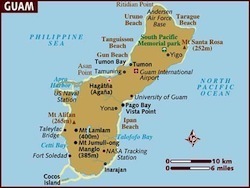 Krystal Paco reports, in Guam News:
Krystal Paco reports, in Guam News:
It’s a bird, it’s a plane, no it’s dead mice baits filled with acetaminophen being dropped from helicopters.
As today marked the fourth mice drop atop forested areas of Anderson Airforce Base since September, U.S. Department of Agriculture assistant state director supervisory wildlife biologist Dan Vice explains the process that’s already proving successful at controlling the local brown tree snake population…. And today, 2,000 dead mice baits were dropped. Each filled with 80 mg of acetaminophen attached to two pieces of cardboard and green tissue….
For the history of this, see “Why dead mice need parachutes in the forest“, which begins:
If you’re going to lace dead mice with poison, and drop them from helicopters into a rainforest in Guam in such a way that they become entangled high in the trees where they might murder the brown tree snakes, but you want to avoid (as much as possible) having the toxically tasty mouse corpses fall all the way to the ground, where they could instead get gobbled by coconut crabs, perhaps you should graft them on to something like a parachute.…
(Thanks to investigator Joanne Manaster for bringing this to our attention.)

Marc Abrahams's Blog
- Marc Abrahams's profile
- 14 followers


